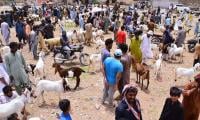Fifth column
The Kashmiris girls are on the streets of Indian-Occupied Jammu and Kashmir and this is big news. Clad in their shining white uniforms and neatly-tucked dupattas or black jellabiyas with headscarves wrapped around their heads, these girl students have captivated audiences at home and abroad for several weeks as they are seen challenging the brutal architecture of the Indian occupation with convincing force.
For over two weeks, hundreds of photographs – from Srinagar and Budgam in Central Kashmir to the frontier district Kupwara or Pulwama in South Kashmir – have captured thousands of girls with schools bags shouting slogans for azadi and contesting the control of the ubiquitous and trigger-happy Indian Army soldiers. Some of the images and videos show teenage girls throwing stones at the Indian paramilitary forces or kicking their armoured vehicles, which are the symbols of fear and dominance.
The Kashmiri girls seem to have awakened the unprecedented power of their gender to dominate the struggle for azadi and the news this struggle engenders. And they have dominated the headlines for their defiance, fierce display of street protest and unwillingness to yield to a ruthless and brutal war machine that India has put in place. A photograph depicting a teenage student in her black jellabiya and white sneakers kicking an Indian paramilitary armoured vehicle went viral last month. It has become an iconic representation to capture and depict the spirit of defiance and fearlessness of Kashmiri girl students.
Later, in a newspaper interview, the unnamed girl said: “I knew my kick wouldn’t change anything, but I felt some sort of satisfaction for the first time in my life”. Marosha Muzafar, another student who has been part of the street demonstrations, justified their public outpour of anger. She said: “we have seen blood of our brothers, sisters, mothers and fathers running through the streets like that of sheep when butchered. How long do you think one would remain indifferent?”
The protests started on April 12, when the Indian Army soldiers barged into the Government Degree College in Pulwama with their armoured vehicles. The incursion of the Indian military into educational institutes is not new. In fact, during the last 30 years of mass pro-freedom protests, the army and paramilitary have occupied hundreds of schools and colleges and turned them into camps and torture centres.
However, as the fear of the Indian Army and its paramilitary forces has largely melted away, the armoured vehicles were met by a defiant group of students who quickly organised a protest and chased them away. Three days later, a large contingent of the army and the police attacked the college with hundreds of shells, pellet guns and tear gas shells. They also pelted stones at the students and beat dozens of them ruthless. More than 100 students, comprising a large number of girl, were injured – and many of them critically.
This unfolded a new dimension of pro-freedom public demonstrations – including protests by girl students – that spread fast and became stronger by the day even though the Indian paramilitary forces and the police used disproportionate and brute force. The protests were peaceful in the beginning. They only turned violent after the Indian military forces initiated violence. They attacked the girls with tear gas shells and shot gun pellets as well as stones, causing grievous injuries to several students.
Describing what motivated her and other students to mount a defiant resistance, Afsha Anjum, a third-year commerce student, told an Indian website: “We came on the streets to register a simple protest against what happened in the Pulwama college. [But] the forces outside abused us and slapped one of our girls…then we threw whatever we could lay our hands on, at them.”
Iqra Siddiq, a student at the Government College for Women, Nawakadal, Srinagar, who was critically injured during one of the protests told journalists: “We were peacefully protesting when we reached Eidgah Chowk. The policemen allowed us to move forward, but a stone was thrown from a bunker of the Central Reserve Police Force (CRPF) that hit my head”. Speaking from a hospital bed inside Srinagar’s SMHS Hospital with her head fractured, she remains resolute. “If I recover soon, I will be part of every student protest. I have a reason now to be involved”.
In their heartless display of barbarity, the Indian forces have shelled various campuses of women’s colleges to break the spirit of defiance among the students. However, the spirit of the protesters remains untamed as the violence fails to stem the defiance. Describing one of the first demonstrations by the girl students in Lal Chowk at the heart of Srinagar city, The Hindu, a prestigious Indian English daily, quoted an unnamed senior police officer as being thoroughly surprised by the protests. He said: “Even stun grenades, PAVA shells and tear-smoke shells failed to deter these girl students. They managed to come out more than eight times despite tear-smoke shelling”.
As the powerful protests by the girl students enter their second month, they seem to have emasculated the architecture of occupation further while advancing the delegitimisation of the Indian rule. This has also exposed the ruling pro-India PDP, headed by Mehbooba Mufti – a woman – and her willingness to use massive force to quell women’s protests just to please the extremist Hindu lobby with whom she shares the power. But the fear of death or the dread of the Indian military forces seems to have faded as the girls chase the occupation forces with their sheer determination and a little aid from stones.
Postscript: As a measure to control the protests, the Indian government initiated a month-long ban on social media and networking sites. There is also talk of a blanket ban on the internet in the coming days. In addition, the Indian government has banned some 30 television channels, mostly from Pakistan. This includes a sports channel, a music channel and two culinary channels that exposed Kashmiris to sumptuous and mouth-watering Pakistani foods. The government order signed by RK Goyal, the principal secretary at the home department, said these channels had the “potential to encourage or incite violence and create law and order disturbance in the Kashmir Valley”.
Twitter: @murtaza_shibli
People stand in line up as election officials check their ballot papers during voting general election at a polling...
Women show their voter identity cards as they stand in a queue before casting their votes in Agartala. — PTIThe 18th...
Former prime minister Imran Khan. — Instagram/ imrankhan.ptiAn old saying has it that “when you dance with the...
Kashmiris in Indian illegally occupied Kashmir protesting against the Indian occupation as the forces of India looked...
A representational image showing residents walking at a wholesale market in Karachi. — AFP/FileOnce again there is...
A representational image showing late Pakistani human rights activist and Supreme Court lawyer Asma Jahangir. —...







